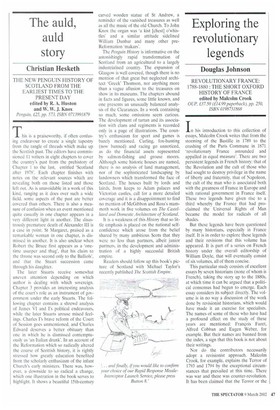The auld, auld story
Christian Hesketh
THE NEW PENGUIN HISTORY OF SCOTLAND FROM THE EARLIEST TIMES TO THE PRESENT DAY edited by R. A. Huston and W. W. J. Knox
Penguin, £25, pp. 573, ISBN 0713991879
This is a praiseworthy, if often confusing endeavour to create a single tapestry from the tangle of threads which make up the Scottish past, The editors have commissioned 11 writers in eight chapters to cover the country's past from the prehistory of Chapter 1 to the last, entitled 'Scotland after 1978'. Each chapter finishes with notes on the relevant sources which are revealing both on those listed and those left out. As is unavoidable in a work of this kind, ranging as it does over such a wide field, some aspects of the past are better covered than others. There is also a measure of confusion when an event mentioned quite casually in one chapter appears in a very different light in another. The disastrously premature death of Alexander III is a case in point. St Margaret, praised as a remarkable woman in one chapter, is dismissed in another. It is also unclear when Robert the Bruce first appears as a 'onetime usurper and thug', that his claim to the throne was second only to the Balliols', and that the Stuart succession came through his daughter.
The later Stuarts receive somewhat uneven attention depending on which author is dealing with which sovereign. Chapter 3 provides an interesting analysis of the court's role as an instrument of government under the early Stuarts. The following chapter contains a shrewd analysis of James VI and I's political endeavours, while the later Stuarts arouse mixed feelings. Charles I's brave reform of the Court of Session goes unmentioned, and Charles Edward deserves a better obituary than one in which he is dismissed contemptuously as 'an Italian drunk'. In an account of the Reformation which so radically altered the course of Scottish history, it is rightly stressed how greatly education benefited from the scholarly enthusiasm of the infant Church's early ministers. There was, however, a downside to so radical a change, which one illustration in the book serves to highlight. It shows a beautiful 15th-century carved wooden statue of St Andrew, a reminder of the vanished treasures as well as all the music of the old Church. To John Knox the organ was 'a kist [chest] o'whisties' and a similar attitude sidelined William Dunbar and many other preReformation `makars'.
The Penguin History is informative on the astonishingly rapid transformation of Scotland from an agricultural to a largely industrialised country. The expansion of Glasgow is well covered, though there is no mention of that great but neglected architect 'Greek' Thomson, nor anything more than a vague allusion to the treasures on show in its museums. The chapters abound in facts and figures, some little known, and one presents an unusually balanced analysis of the Clearances. In a work containing so much, some omissions seem curious The development of tartan and its association with clans and regiments is recorded only in a page of illustrations. The country's enthusiasm for sport and games is barely mentioned. Curling, fox-hunting (now banned) and racing go unnoticed, as do the financial assets represented by salmon-fishing and grouse moors. Although some historic houses are named, there is no analysis of land management, nor of the sophisticated landscaping by landowners which transformed the face of Scotland. The houses built by lords and lairds, from keeps to Adam palaces and Victorian castles, call for a more detailed coverage and it is a disappointment to find no mention of McGibbon and Ross's mammoth work in five volumes on The Castellated and Domestic Architecture of Scotland.
It is a weakness of this History that so little emphasis is placed on the national selfconfidence which arose from the belief shared by many ambitious Scots that they were no less than partners, albeit junior partners, in the development and administration of a highly successful British empire.
Readers should follow up this book's picture of Scotland with Michael Taylor's recently published The Scottish Empire.














































































 Previous page
Previous page